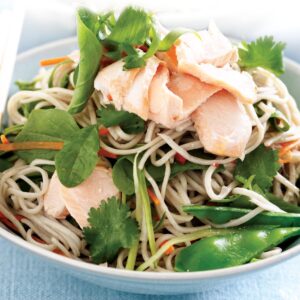
We’re always seeing new trends in food and nutrition. HFG editor Niki Bezzant and HFG senior nutritionist Rose Carr look at some of the latest.
Diet trend: The Paleo Diet
What’s it about?
There are lots of interpretations of this diet but the basic premise is to eat in the same way our Paleolithic hunter-gatherer ancestors did up until about 10,000 years ago.
The diet includes a high amount of meat (ideally free-range or game), fish and seafood plus fruits, vegetables, seeds, nuts, and seeds oils.
We’re told to avoid dairy products, cereal grains, legumes, refined sugars and processed foods which were not on our ancestors’ menu.
What the experts say
- The diet includes high intakes of protein, fibre, omega-3 and other unsaturated fats and very low intakes of saturated fat and sodium compared to typical Western diets.
- Eating only unprocessed foods would cut out a lot of energy and salt, and increase the nutrient-density of our diet.
- Studies last century on 229 remaining hunter-gatherer societies found they were largely free of symptoms of cardio-vascular disease.
- Most of us would lose weight on this diet (no cheese, no wine, no baking, no chocolate…).
- The evidence does not support avoiding whole grains, legumes and low-fat dairy just because they weren’t eaten tens of thousands of years ago. These important food groups provide essential nutrients.
- The ‘banned’ foods in this diet make it difficult to sustain and could lead to disordered eating.
- Eating more meat over grains and legumes is expensive.
Our verdict: Fad
This looks like another fad diet, appealing to people who want rules rather than learning how to develop a better relationship with food. However, by eating more unprocessed foods and increasing our physical activity, we can take the good from our ancestors’ diets without ignoring the current science.
Diet trend: The IF Diet
What’s it about?
IF stands for intermittent fasting. The idea is that if you don’t eat for a couple of days each week then even if you eat anything you like on the other days, you’re bound to consume less energy overall and lose weight.
One version is alternate day modified fasting: on every alternate day we have only 25 per cent of our normal energy intake, for example, 2175kJ instead of 8700kJ, and on the other days we eat whatever we like.
What the experts say
- The few human studies on this diet show people do lose weight because on the feed days they can’t fully make up for the lack of food on the fast days. When overweight or obese, this weight-loss enhances several risk factors for diseases such as cardiovascular disease and type 2 diabetes.
- While it’s possible we could become more attuned to hunger and fullness, critics say this type of eating pattern could also reinforce a poor relationship with food.
- Likely to be unsustainable long-term. If it was kept up long-term, the overall diet would need to be extremely healthy and very nutrient-dense to get all the nutrients needed to maintain good health.
- IF does nothing to encourage healthy eating patterns which you would need in order to maintain any weight-loss after the diet.
- Side-effects of low blood-glucose on fasting days may include light-headedness, feeling irritable and poor decision-making.
- Fasting is easy for lab rats to do as their consumption is externally controlled. But fasting requires willpower in humans. Unfortunately, having low blood glucose actually undermines our willpower (see How to boost your willpower).
Our verdict: Fad
While it may work for a few, many of us would just become lethargic and irritable on the fasting days. Like many fad diets, it’s not a healthy way to eat long term.
Diet trend: The low-FODMAP diet
What’s it about?
FODMAPs stands for fermentable oligosaccharides (fructans, galactans), disaccharides (lactose), monosaccharides (fructose), and polyols (sugar alcohols). These are naturally occurring carbohydrate molecules found in a wide range of common foods.
Some people have difficulty digesting FODMAPS causing symptoms such as bloating and diarrhoea.
People sensitive to FODMAPs can avoid symptoms by following a diet low in FODMAPs. Rather than cutting them out completely, the idea is to recognise where they are and not have too many FODMAPs from different sources within each meal.
What the experts say
- A low-FODMAP diet won’t help everyone with uncomfortable gut symptoms but it can be a revelation for others, including some people previously diagnosed with IBS (irritable bowel syndrome).
- Researchers in Melbourne have found a link between colic symptoms in babies and FODMAPs in the breastfeeding mother’s diet
Our verdict: Here to stay
We think this is an exciting area of research which can help many people with IBS symptoms. But it’s not easy to diagnose the need, or to follow a low-FODMAP diet, so getting professional help is strongly recommended. Simply removing food groups from our diet without knowing how to replace important nutrients is not advisable. The research is still in its infancy and we’re learning more about FODMAPs all the time.
Click here for more on FODMAPs.
Diet trend: Sugar free
What’s it about?
Fans of this diet say sugar as toxic, asserting that because fructose is metabolised differently than glucose, it’s more likely to be transformed into body fat. The focus is on fructose found in table sugar and high fructose corn syrup (HFCS), which is widely used in manufactured foods in North America (but barely used in New Zealand).
Another diet with many versions, some cut out everything containing any type of sugar, others focus solely on fructose, whether from fruit or other sources.
What the experts say
- Many of us would benefit from cutting down on sugary foods. Sugar often comes in food combined with fat, and these both contribute to weight gain — which is a risk factor for insulin resistance and type 2 diabetes.
- The evidence is not there that sugar is toxic, or that fructose makes us fat faster.
- Cutting out all sugar from the diet is restrictive, difficult to do and could lead to an unhealthy relationship with food, as in all restrictive diets.
- There are many proven health benefits from eating fruit — cutting it out is not a good idea.
Our verdict: Fad
There will be more publicity on this diet in 2013. We agree that eating fewer sugary foods is a good idea but we think cutting out all sugar is unnecessary and extreme.
Nutrition trend: Probiotics
What’s it about?
It is normal and healthy for our gastrointestinal tract to host over 500 species of bacteria which can weigh up to one kilogram. These bacteria are critical to the normal development of our immune system and also produce some vitamins and short-chain fatty acids.
Probiotics are live microorganisms which provide a health benefit when provided in adequate amounts by contributing to or modifying the functions of our own bacteria.
What the experts say
- Specific probiotics have been identified which may help with gut disorders as well as allergic disorders such as asthma and eczema.
- Probiotic benefits are species specific. For example, both Lactobacillus rhamnosus GG (LGG) and S boulardii have been found to help prevent antibiotic associated diarrhoea.
- For most people probiotics are completely safe.
- While not strictly food related, an interesting emerging area of research is ‘faecal transplants’. (Yes, it does mean what you’re thinking.) Researchers have successfully used this technique to treat Clostridium difficile bacteria, which causes watery diarrhoea and is very difficult to treat.
- While many yoghurts claim to contain probiotic bacteria, if they don’t have them in proven therapeutic amounts they are unlikely to be therapeutic.
- Most probiotics don’t colonise the gut so to have the desired benefit continued consumption is required.
Our verdict: More to come
Digestive health is a huge issue for many people so we can expect to see more research on both conventional probiotics and the unconventional. While we’re accustomed to probiotic dairy, probiotic fruit juice is sold overseas.
Nutrition trend: Nutrigenetics and Nutrigenomics
What’s it about?
Incorporating nutrition, genetics and biochemistry, these emerging sciences are focused on the interactions between our diet and our genes.
Nutrigenetics is the science of the effect of genetic variation on how we respond to our diet. Nutrigenomics is the science of the role of nutrients and other bioactive compounds in food on gene expression.
Nutrigenomics uses technologies that can look at tens of thousands of genes to reveal changes in gene and protein expression that vary with a person’s diet.
What the experts say
- Currently used only in research, the future offers a world of ‘personalised nutrition’ where we know what we can eat to get the best health from our own genes, potentially preventing, moderating, or treating chronic disease, through dietary changes.
- Nutrigenomic researchers at Auckland University are currently studying how dietary changes can influence Crohn’s disease, a chronic relapsing condition that has no certain cure.
- Nutrigenomics methods have been successfully applied to animal models of Crohn’s disease, and a pilot study with 30 people undertaken in 2012 produced very promising results.
Our verdict
This is an emerging science we will be hearing a lot more about.
New gadgets
Could these be in your kitchen in the future?
Thermomix
$2410, www.thermomix.co.nz
A multi-purpose machine often used in restaurant kitchens, the Thermomix chops, beats, mixes, mills, emulsifies, kneads, stirs, weighs, melts, cooks and heats all in one compact appliance. It is simple to use and easy to clean.
Our verdict
This is an amazing machine that can do the job of at least six other appliances. It would be a wonderful gadget for people with food allergies or intolerances who want to mill their own flours or grains, and we love the ease of it for kneading dough and scones. For less confident cooks it provides fool-proof results on dishes you might otherwise never attempt.
At this price you would have to be committed to using the Thermomix every day to get value but we suspect if you had one in your kitchen, you probably would.
Breville Sous Vide Supreme
$999 (excluding the vac-pac sealer), www.breville.co.nz
Sous Vide cooking (literally ‘under vacuum’) is a method of cooking popular with restaurant chefs. Food is sealed in airtight plastic bags then cooked in a water bath. The theory is that this retains juices and flavours in meats and vegetables. This machine allows home cooks to achieve the same thing.
Our verdict
Great fun for the serious foodie with space in the kitchen and a keenness to experiment. You have to plan ahead — but if you’re entertaining it could be really convenient as the food can be kept at serving temperature for hours with no loss of quality. Makes amazingly tender meat and poultry.
Yonanas
$109, www.yonanas.com
This machine takes one ingredient — frozen bananas — and turns them into soft-serve style ‘ice cream’. It’s easy to use and comes apart for cleaning.
Our verdict
This is a lot of fun for kids and a good way to get them eating fruit. It would make a nice gift for a family.
New products we expect to see on the shelves this year
- luxury cereals
- more gluten-free crackers, bread and sweets
- instant and single-serve breakfasts
- more products sweetened with stevia
- more lactose-free dairy products
Flash in the pan – food trends we predict won’t last
- pre-flight drinks
- ‘nutritional’ cookies
- vitamin gum
- Himalayan salt
- ‘activated’ almonds
www.healthyfood.com










